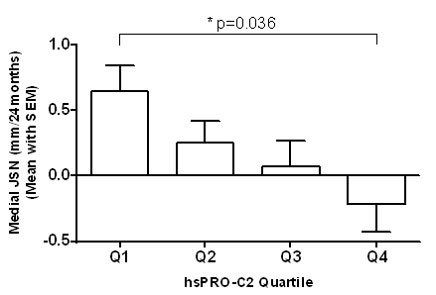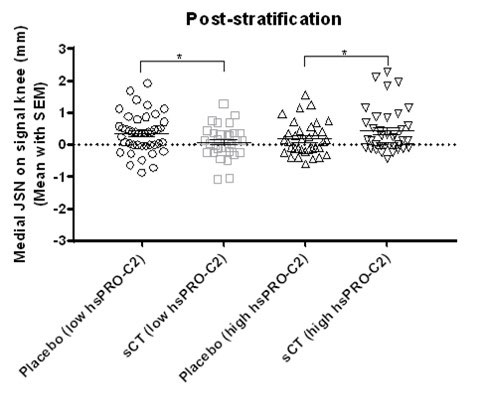Session Information
Session Type: Poster Session (Tuesday)
Session Time: 9:00AM-11:00AM
Background/Purpose: Osteoarthritis (OA) is a highly heterogeneous disease, which suggest that multiple endotypes exist. Identification and characterization of such endotypes may assist in precision medicine for identification of faster progressors whom may benefit from a given type of intervention. Recent published data have shown that SNPs in growth factors such as TGFbeta and GDF are associated with OA, which indicate that cartilage formation and repair play an important role in progression of OA. The aim was to determine whether a biomarker of type II collagen formation measured in serum, as a potential surrogate measure of cartilage formation, could predict radiographic progression in knee OA population. Subsequently, we investigated if such a proposed low cartilage formation/repair endotype was more responsive to a potential treatment of OA.
Methods: hsPRO-C2, a measurement of the type II collagen pro-peptide, was measured in blood samples of two independent knee OA cohorts: 106 recruited at New York University (NYU cohort) and 147 from the phase III OA trial SMC021-2301 (clinicaltrial.gov: NCT00486434) evaluating the efficacy and safety of oral salmon calcitonin. Patients were dichotomized based on their baseline level of hsPRO-C2 and the mean difference in two-year radiographic progression (joint space narrowing (JSN)) was analyzed using ANCOVA adjusting for baseline demographics and clinical characteristics.
Results: In the NYU cohort, baseline plasma hsPRO-C2 levels were negatively correlated with the progression of radiographic JSN (r = -0.26, p = 0.009). Quartile analysis demonstrated a significant difference in mean JSN from quartile 1 to 4 (0.51 mm versus -0.07 mm, p = 0.036, fig. 1). Knee OA patients with low hsPRO-C2 levels (≤ 1.48 ng/mL) revealed significantly larger JSN compared to the individuals with high hsPRO-C2 levels ( > 1.48 ng/mL) at 24 months (0.37 mm vs 0.02 mm, p = 0.042). In the SMC cohort, there was no significant treatment effect on the medial JSN over 2 years before stratification by hsPRO-C2; however, as observed in the NYU cohort, JSN was on average higher in the low hsPRO-C2 (≤ 1.96 ng/mL) group compared to the high group ( > 1.96 ng/mL). Furthermore, in the low baseline hsPRO-C2 subgroup, sCT-treated patients on average had a lower JSN compared to placebo patients (p < 0.05, fig. 2). The opposite trend was observed in patients with high baseline hsPRO-C2.
Conclusion: Here we show that low levels of cartilage formation, measured by PRO-C2, were associated with radiographic progression and greater likelihood of response to a salmon calcitonin. Low PRO-C2 may provide a measure of an OA endotype with low background cartilage formation (at baseline) and higher capacity for repair when treated with a potential cartilage anabolic drug.
To cite this abstract in AMA style:
Luo Y, Samuels J, Krasnokutsky S, Byrjalsen I, Andersen J, Bihlet A, He Y, Karsdal M, Abramson S, Attur M, Bay-Jensen A. A Low Cartilage Formation & Repair Endotype Predicts Radiographic Progression in Symptomatic Knee Osteoarthritis Patients and Identifies Optimal Responders to a Potential OA Treatment [abstract]. Arthritis Rheumatol. 2019; 71 (suppl 10). https://acrabstracts.org/abstract/a-low-cartilage-formation-repair-endotype-predicts-radiographic-progression-in-symptomatic-knee-osteoarthritis-patients-and-identifies-optimal-responders-to-a-potential-oa-treatment/. Accessed .« Back to 2019 ACR/ARP Annual Meeting
ACR Meeting Abstracts - https://acrabstracts.org/abstract/a-low-cartilage-formation-repair-endotype-predicts-radiographic-progression-in-symptomatic-knee-osteoarthritis-patients-and-identifies-optimal-responders-to-a-potential-oa-treatment/


